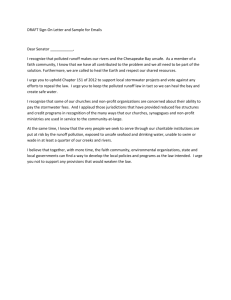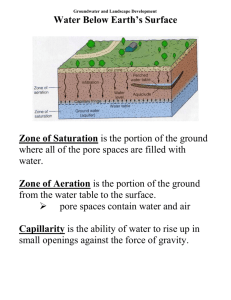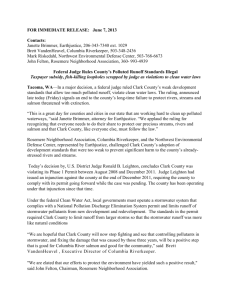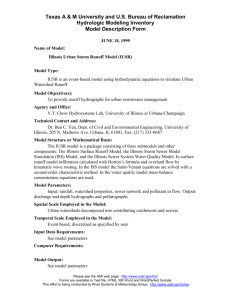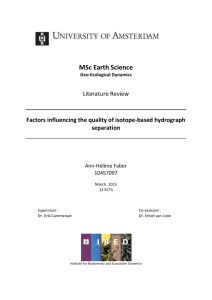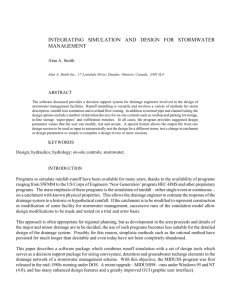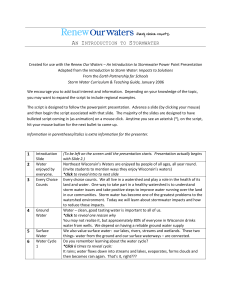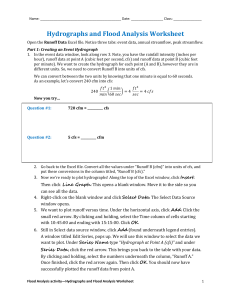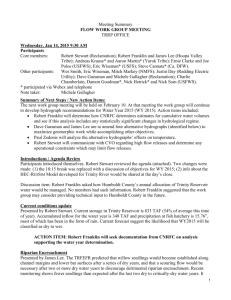Topic02_Hydrology_CV
advertisement
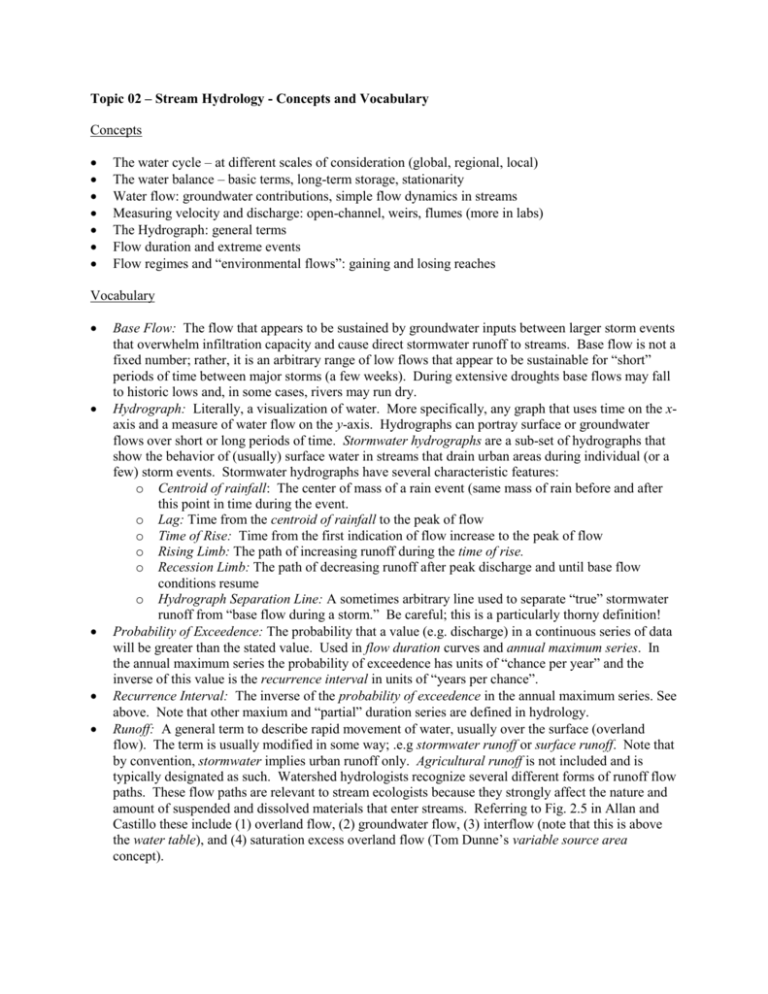
Topic 02 – Stream Hydrology - Concepts and Vocabulary Concepts The water cycle – at different scales of consideration (global, regional, local) The water balance – basic terms, long-term storage, stationarity Water flow: groundwater contributions, simple flow dynamics in streams Measuring velocity and discharge: open-channel, weirs, flumes (more in labs) The Hydrograph: general terms Flow duration and extreme events Flow regimes and “environmental flows”: gaining and losing reaches Vocabulary Base Flow: The flow that appears to be sustained by groundwater inputs between larger storm events that overwhelm infiltration capacity and cause direct stormwater runoff to streams. Base flow is not a fixed number; rather, it is an arbitrary range of low flows that appear to be sustainable for “short” periods of time between major storms (a few weeks). During extensive droughts base flows may fall to historic lows and, in some cases, rivers may run dry. Hydrograph: Literally, a visualization of water. More specifically, any graph that uses time on the xaxis and a measure of water flow on the y-axis. Hydrographs can portray surface or groundwater flows over short or long periods of time. Stormwater hydrographs are a sub-set of hydrographs that show the behavior of (usually) surface water in streams that drain urban areas during individual (or a few) storm events. Stormwater hydrographs have several characteristic features: o Centroid of rainfall: The center of mass of a rain event (same mass of rain before and after this point in time during the event. o Lag: Time from the centroid of rainfall to the peak of flow o Time of Rise: Time from the first indication of flow increase to the peak of flow o Rising Limb: The path of increasing runoff during the time of rise. o Recession Limb: The path of decreasing runoff after peak discharge and until base flow conditions resume o Hydrograph Separation Line: A sometimes arbitrary line used to separate “true” stormwater runoff from “base flow during a storm.” Be careful; this is a particularly thorny definition! Probability of Exceedence: The probability that a value (e.g. discharge) in a continuous series of data will be greater than the stated value. Used in flow duration curves and annual maximum series. In the annual maximum series the probability of exceedence has units of “chance per year” and the inverse of this value is the recurrence interval in units of “years per chance”. Recurrence Interval: The inverse of the probability of exceedence in the annual maximum series. See above. Note that other maxium and “partial” duration series are defined in hydrology. Runoff: A general term to describe rapid movement of water, usually over the surface (overland flow). The term is usually modified in some way; .e.g stormwater runoff or surface runoff. Note that by convention, stormwater implies urban runoff only. Agricultural runoff is not included and is typically designated as such. Watershed hydrologists recognize several different forms of runoff flow paths. These flow paths are relevant to stream ecologists because they strongly affect the nature and amount of suspended and dissolved materials that enter streams. Referring to Fig. 2.5 in Allan and Castillo these include (1) overland flow, (2) groundwater flow, (3) interflow (note that this is above the water table), and (4) saturation excess overland flow (Tom Dunne’s variable source area concept). Stationarity: The assumption that certainly critical variables in a model will remain constant (stationary) over time. A widely used concept to simplify models that has come to be criticized due to long-term changes in environmental variables such as climate, population, and land use. Water Table: The elevation (depth) in soil that is the interface between the saturated (phreatic) and unsaturated (vadose) zones in a soil in which this surface is free to rise and fall in the soil and underlying geologic formations (regolith). Such a saturated zone is an unconfined aquifer. Some aquifers (water bearing strata) may be confined above and below by restricting layers (e.g. clay or highly compressed soils and for this reason are called confined aquifers. Confined aquifers can have unusual impacts on streams, e.g., springs, contributions of contaminants that appear to come from distant locations.


